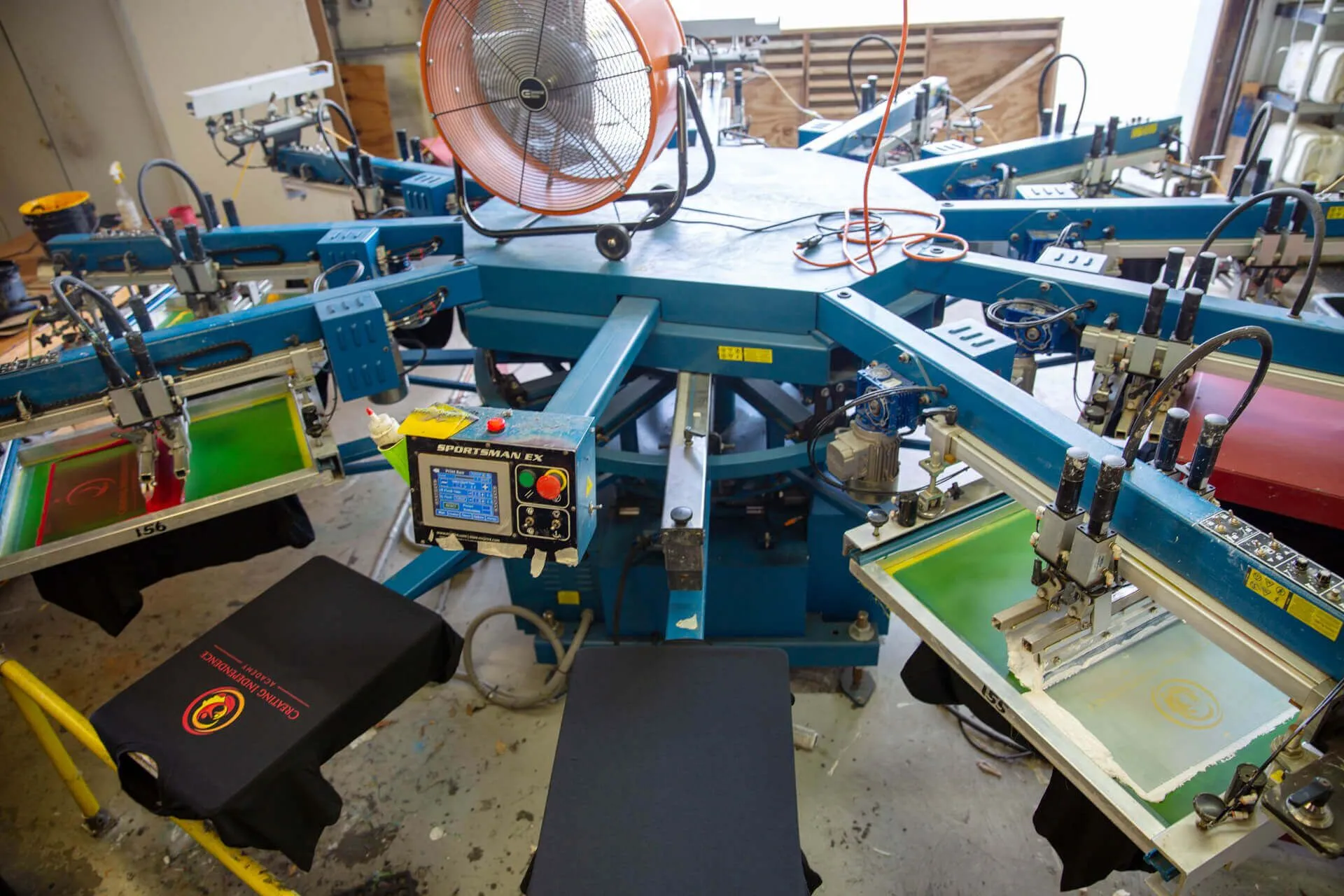Silk Screen Printing for Bold and Lasting Designs
Silk Screen Printing for Bold and Lasting Designs
Blog Article
Display Printing Uncovered: Everything You Need to Find Out About Tee and Garment Printing Methods
Screen printing is a fascinating approach that integrates art with strategy, supplying limitless possibilities for imagination. Prepared to explore the necessary aspects that make screen publishing an art kind?
The Basics of Display Printing: Just How It Functions
When you dive into display printing, you'll discover it's both an art and a scientific research. At its core, screen printing involves creating a pattern, or display, that allows ink to go through only in certain locations (screen printing kit). You begin by picking your layout and preparing your display with a light-sensitive solution. When you expose this emulsion to light, it hardens, leaving your design as an unfavorable room.
Following, you'll mix your inks and prepare your printing surface. Placement the display over the textile, after that utilize a squeegee to press ink through the screen onto the garment. This process needs precision, as you want clear, vibrant prints. After printing, you'll cure the ink with heat, ensuring it sticks to the material and lasts through cleans. Each action is necessary, and grasping them will certainly elevate your screen printing skills, changing easy garments into one-of-a-kind, meaningful items.
Sorts Of Screen Printing Techniques
Once you understand the fundamentals of screen printing, it's time to discover the different strategies that can boost your designs. One preferred approach is typical screen printing, where ink is pressed with a stenciled screen. This strategy is wonderful for bold, vibrant colors. Then there's water-based ink printing, which uses a softer feel and is eco-friendly, yet it requires a different strategy to healing.
If you're intending for great information, take into consideration discharge printing. This technique removes color from the textile, leaving a soft, classic look. Another alternative is plastisol printing, understood for its durability and vibrant colors, making it a favored for lots of brand names. Experiment with halftone printing to produce gradient effects and complex designs. Each method has its one-of-a-kind appeal, so do not be reluctant to try them bent on discover what matches your style best!
Essential Devices for Screen Printing
To achieve sensational outcomes in display printing, having the appropriate tools is basic. You'll require a tough display printing structure, which holds the mesh that moves your layout onto the garment. Next off, spend in top quality squeegees; these are necessary for using ink evenly across the display.
Choosing the Right Inks and Materials
When selecting inks and products for screen printing, you need to consider the kind of ink that works finest for your project. Assume about textile compatibility to ensure your styles look wonderful and last lengthy. Likewise, check out green ink alternatives to make your printing procedure much more sustainable.
Sorts Of Display Inks
Picking the best display ink is crucial for accomplishing vibrant, long lasting prints that satisfy your project's demands. There are a number of kinds of display inks to take a look at. Specialty inks, such as glow-in-the-dark or metal, can add distinct effects to your styles.

Material Compatibility Considerations
Understanding material compatibility is essential for accomplishing high-quality screen prints, particularly since various products respond uniquely to different inks. Always evaluate your inks on example fabric to ensure they stick appropriately and maintain shade honesty. Additionally, maintain in mind that textile weight and texture can influence the final result, so picking the right ink and product combination is important for your task's success.
Eco-Friendly Ink Options
Green inks are coming to be a preferred option for screen printers who want to reduce their environmental effect while preserving high quality. When choosing inks, think about water-based inks, which are less dangerous and less complicated to clean up contrasted to conventional solvents.
Furthermore, seek inks made from renewable resources, such as soy or vegetable-based choices. By picking the best inks and products, you'll not only produce magnificent layouts however additionally add to a more lasting printing procedure. Make the button, and your prints will certainly reflect your dedication to the environment!
Preparing Your Layout for Display Printing

File Format Needs
To assure your design looks dynamic and sharp on material, you'll need to pay close attention to file style demands for screen printing. Make sure your style has a clear history to prevent unwanted white edges on your prints. Maintain shade modes in mind; CMYK is conventional Extra resources for display printing, so convert your RGB develops as necessary.
Color Separation Techniques
Shade splitting up is a crucial action in preparing your layout for screen printing, and understanding it can greatly enhance your print quality. You'll require to break your design right into individual shades, as each color requires a separate display throughout printing. This accuracy not only ensures precise color depiction but likewise simplifies the printing process.
Resolution and Size
Achieving the most effective cause display printing begins with assuring your style has the appropriate resolution and size. Preferably, your art work needs to go to the very least 300 DPI (dots per inch) for sharp, clear prints. Your last item might look pixelated and amateur. if you make use of lower resolution.
When it involves size, think about the measurements of your print area. Style your art work to match the final print dimension, ideally producing it in the real dimensions you'll be publishing. By doing this, you'll stay clear of any kind of unexpected scaling problems.
Always inspect your design in both vector and raster layouts. Vector graphics can be scaled without shedding quality, making them excellent for screen printing. Preparing properly will assure your layout looks outstanding on every garment!
Step-by-Step Screen Printing Process
Display printing is a vibrant process that allows you to develop vibrant designs on numerous surfaces. To start, you'll need a display, solution, and your picked ink. Prepare your screen by cleansing it completely. Next off, use the emulsion uniformly and let it completely dry in a dark location. As soon as completely dry, reveal your display to light with your style put on it, which will certainly solidify the emulsion where the light hits, producing a stencil - screen printing kit.
After rinsing the unexposed emulsion, your display prepares. Establish it up on your printing surface area and straighten your garment under it. Put ink onto the display and make use of a squeegee to press the ink via the pattern onto the textile. Raise the display thoroughly and let the print dry. Cure the ink using why not try here heat to ensure longevity. That's it! You have actually successfully display printed your design.
Tips for Successful Screen Printing Projects
While you're diving into your screen printing projects, bear in mind that prep work is essential to success. Beginning by collecting all your products-- inks, garments, screens, and mops. A tidy workspace aids stop unwanted mistakes, so clean prior to you start.
Following, confirm your art work is high-resolution and correctly sized for your garment. Test your screen for appropriate exposure and clean it completely to stay clear of smudges. When blending your inks, comply with the producer's standards to accomplish the best uniformity.
Throughout printing, apply also pressure with your squeegee for regular outcomes. Don't rush; take your time to confirm each print meets your standards. After printing, let your garments completely dry completely before taking care of or packaging them.
Lastly, constantly keep a sample of your benefit future referral. By doing this, you can evaluate your progression and improve your techniques gradually. Satisfied printing!

Regularly Asked Inquiries
For how long Does It Require To Set up a Screen Printing Task?
Establishing a screen printing task typically takes about thirty minutes to an hour. You'll prepare the screens, mix inks, and adjust the press. The time differs based on complexity and experience, so remain organized!
Can I Publish on Different Material Types Utilizing the Very Same Strategy?
Yes, you can publish on different material kinds making use of the very same strategy, however you'll need to adjust your inks and setups. Some fabrics soak up ink in different ways, so trying out assurances the most effective results for each product.
What Prevail Blunders to Stay Clear Of in Screen Printing?
When display printing, prevent common blunders like utilizing the incorrect ink, disregarding appropriate exposure times, or missing pre-press checks. Always test your arrangement and preserve clean screens to assure high quality results each time.
How Can I Effectively Tidy and Preserve My Screen Printing Devices?
To correctly clean and maintain your display printing devices, you ought to on a regular basis wash displays with appropriate solvents, inspect squeegees for wear, and ensure all devices are kept completely dry and dust-free. Uniformity enhances and protects against costly repair services performance.
Is Display Printing Eco-friendly Compared to Other Approaches?
Screen printing can be a lot more ecologically pleasant than other techniques, especially if you utilize water-based inks and eco-conscious materials. By choosing lasting materials and techniques, you minimize waste and reduce your effect on the earth.
Display Printing Uncovered: Every Little Thing You Required to Know Regarding T-Shirt and Garment Printing Techniques
At its core, display printing includes developing a stencil, or screen, that permits ink to pass with only in particular locations. Setting the screen over the material, after that use a squeegee to push ink through the screen onto the garment. One prominent technique is standard display printing, where ink is pop over here pressed via a stenciled display.When picking inks and materials for screen printing, you need to take into account the type of ink that functions best for your task.
Report this page